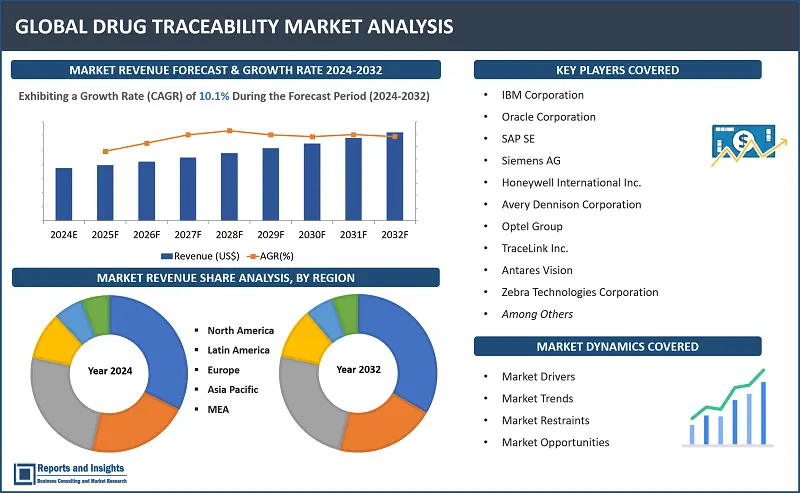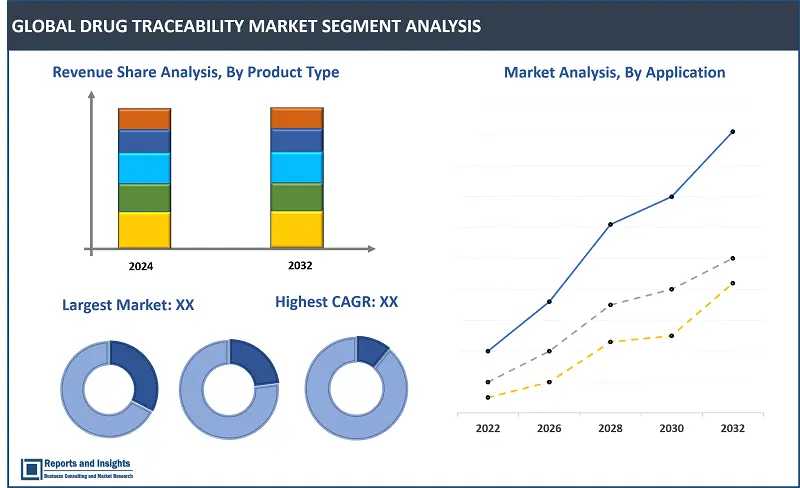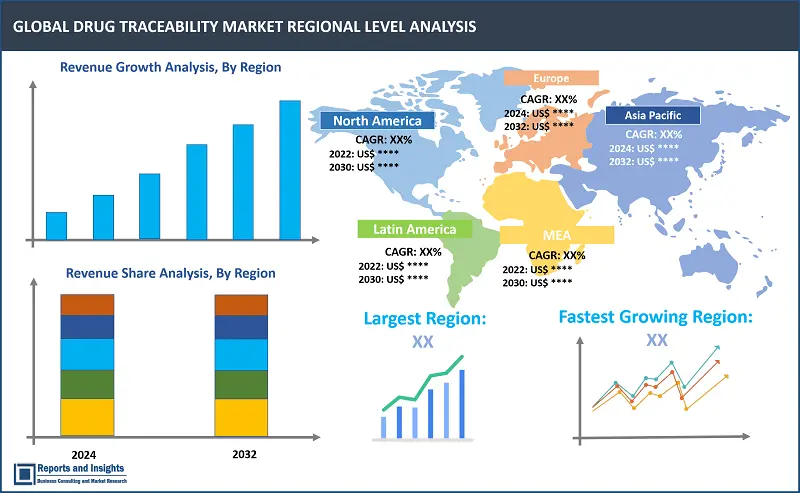Market Overview:
"According to Reports and Insights analysis, the global drug traceability market to register a revenue CAGR of 10.1% during the forecast period."
|
Report Attributes |
Details |
|
Base Year |
2023 |
|
Forecast Years |
2024-2032 |
|
Historical Years |
2021-2023 |
|
Market Growth Rate (2024-2032) |
10.1% |
Drug traceability is a critical component of the pharmaceutical industry, ensuring the integrity and safety of the drug and medicine supply chain. Cutting-edge technologies and sophisticated software play a pivotal role in achieving this goal. Utilizing blockchain, Radio-Frequency Identification (RFID), and advanced data analytics, companies are able to implement comprehensive drug traceability solutions. One such innovative product is TrackMed, which is a state-of-the-art traceability software that employs blockchain to create an immutable record of every drug's journey from manufacturer to consumer. Its technical prowess lies in real-time monitoring, serialization, and integration with existing supply chain systems. The benefits of such systems include enhanced security, transparency, and the ability to quickly identify and rectify any anomalies in the distribution network. This transformative technology not only meets regulatory requirements, but also enhances consumer confidence by providing an auditable and transparent trail of the drug's lifecycle, ensuring the delivery of safe and authentic pharmaceuticals.
The global drug traceability market is registering steady revenue growth, driven by a number of key factors. Stringent regulatory requirements mandating traceability for pharmaceuticals are driving adoption of advanced technologies. The need to combat counterfeit drugs entering the market is enhancing adoption among pharmaceutical companies and increasing investments in traceability solutions. The implementation of serialization and track-and-trace systems, often leveraging technologies like RFID and blockchain, ensures transparency and accountability throughout the supply chain.

Drug Traceability Market Drivers and Trends:
Stringent regulatory mandates, such as the Drug Supply Chain Security Act (DSCSA) in the US and similar regulations worldwide, require pharmaceutical companies to implement traceability measures. Also, increasing entry and presence of counterfeit drugs in the market is resulting in companies investing in traceability technologies to ensure product authenticity. In addition, increasing focus among retailers to stock genuine pharmaceuticals and ability to identify counterfeit products is driving demand for traceability solutions. Moreover, advancements in technology, particularly RFID and blockchain, offer efficient and secure traceability capabilities.
Companies can leverage strategies such as integrating serialization and track-and-trace technologies, implementing cloud-based traceability platforms, and forging collaborations with technology providers. Also, adopting real-time monitoring and analytics can enhance supply chain visibility. By proactively adopting these strategies and scenarios, companies position themselves to benefit from enhanced regulatory compliance, reduced counterfeiting risks, improved consumer trust, and streamlined operations. Ultimately, this strategic approach contributes to revenue growth in the global drug traceability market as pharmaceutical firms respond adeptly to evolving market demands and regulatory landscapes.
Drug Traceability Market Restraints:
High implementation costs pose a significant barrier for many pharmaceutical companies, especially smaller players. Interoperability challenges also arise due to the diverse technology landscape within the pharmaceutical supply chain, making integration complex. Resistance to change and lack of awareness among stakeholders are other key factors that can impede the adoption of new traceability technologies. Also, concerns about data security and privacy, especially with the use of emerging technologies like blockchain, can slow down the acceptance of traceability solutions. In addition, the absence of standardized global regulations creates ambiguity and inconsistency in compliance requirements across regions, further complicating implementation efforts.
While specific historical statistics may vary, the mentioned factors collectively contribute to a slower-than-expected growth trajectory for the global drug traceability market. Overcoming these barriers necessitates concerted efforts from industry stakeholders, including regulatory bodies, to address cost concerns, promote standardization, and increase awareness, ultimately facilitating a more seamless adoption of drug traceability solutions and unlocking their revenue potential.
Drug Traceability Market Opportunity:
Leading players can develop comprehensive regulatory compliance solutions tailored to diverse global markets, helping pharmaceutical companies navigate complex and evolving regulatory landscapes seamlessly. With increasing regulatory scrutiny, providing adaptable solutions ensures that companies can efficiently comply with various regional requirements, positioning the leading players as essential partners in the pharmaceutical supply chain. Also, implementing artificial intelligence and machine learning in drug traceability systems can enhance predictive analytics, anomaly detection, and supply chain optimization, offering more robust and intelligent traceability solutions. By leveraging advanced technologies, leading players can offer innovative solutions that not only trace the drug's journey, but also provide valuable insights for operational efficiency and risk mitigation. Furthermore, leading players can invest in blockchain technologies to establish transparent and immutable supply chain records, ensuring trust and security in the pharmaceutical distribution process. Blockchain's decentralized and tamper-resistant nature addresses concerns related to data integrity and authenticity, fostering confidence among stakeholders and setting industry leaders apart.
Moreover, developing interoperable traceability systems that seamlessly integrate with existing technologies and supply chain platforms enhances efficiency and encourages widespread adoption. Companies offering interoperable solutions cater to the diverse technology landscape in the pharmaceutical industry, making it easier for clients to adopt and integrate traceability measures without major disruptions.
Drug Traceability Market Segmentation:

By Technology Type:
- Radio-Frequency Identification (RFID)
- Barcode
- Blockchain
- Global Positioning System (GPS)
- Internet of Things (IoT)
The blockchain segment is expected to account for largest revenue share in the global drug traceability market over the forecast period. This can be attributed to increasing adoption of blockchain technology owing to ability to provide an immutable and transparent record of pharmaceutical supply chains, ensuring data integrity and security. Blockchain's decentralized nature minimizes the risk of tampering and counterfeiting, aligning with stringent regulatory requirements. Also, the demand for real-time traceability solutions, which blockchain effectively facilitates, further drives integration and use. As pharmaceutical companies prioritize robust traceability mechanisms, the blockchain segment is expected to continue to register substantial revenue growth.
By End-User Industry:
- Pharmaceuticals Manufacturers
- Contract Manufacturing Organizations (CMOs)
- Wholesale Distributors
- Dispensaries/Pharmacies
- Healthcare Providers
The pharmaceutical manufacturers segment is expected to account for largest revenue share in the global drug traceability market. This projection is substantiated by the fact that manufacturers play a pivotal role in implementing traceability solutions to comply with stringent regulations and safeguard product authenticity. As regulatory authorities increasingly emphasize traceability throughout the supply chain, pharmaceutical manufacturers prioritize robust systems to maintain compliance. Also, the need for serialization and track-and-trace technologies is inherently higher at the manufacturing stage, further driving the revenue share of this segment.
By Product Type:
- Hardware
- Scanners
- Printers
- Other
- Software
- Traceability Platforms
- Analytics
- Services
- Consulting
- Maintenance
- Middleware
- Labels and Tags
Based on product type, the market is segmented into hardware, software, services, middleware, and label & tags. The hardware segment is expected to account for the largest revenue share in the market, and software segment is expected to grow at a highest CAGR in comparison to other segments.
By Application:
- Serialization
- Track and Trace
- Authentication
- Aggregation
- Tamper-Evident
By Level of Traceability:
- Unit-Level Traceability
- Batch-Level Traceability
- Parenteral-Level Traceability
- Case-Level Traceability
- Pallet-Level Traceability
Segmentation By Region:

North America:
- United States
- Canada
Asia Pacific:
- China
- India
- Japan
- Australia & New Zealand
- Association of Southeast Asian Nations (ASEAN)
- Rest of Asia Pacific
Europe:
- Germany
- The U.K.
- France
- Spain
- Italy
- Russia
- Poland
- BENELUX (Belgium, the Netherlands, Luxembourg)
- NORDIC (Norway, Sweden, Finland, Denmark)
- Rest of Europe
Latin America:
- Brazil
- Mexico
- Argentina
- Rest of Latin America
The Middle East & Africa:
- Saudi Arabia
- United Arab Emirates
- South Africa
- Egypt
- Israel
- Rest of MEA (Middle East & Africa)
The United States (US) is the largest market for drug traceability solutions, and this can be attributed to several key factors. Primarily, the US has implemented stringent regulatory frameworks, such as the Drug Supply Chain Security Act (DSCSA), mandating the use of traceability solutions to combat counterfeiting and ensure the integrity of the pharmaceutical supply chain. Also, the sheer size and complexity of the US pharmaceutical market, coupled with a relatively high focus on patient safety and regulatory compliance, necessitate advanced traceability measures. In addition, the presence of a highly developed healthcare infrastructure and a proactive approach by pharmaceutical companies in adopting innovative technologies contribute to the wider adoption of drug traceability solutions in the country. These factors collectively position the country at the forefront among other country-level markets in the global drug traceability solutions market.
In Europe, several key trends are expected to drive the adoption of drug traceability solutions in the pharmaceutical industry. Increasing prevalence of counterfeit drugs is a major issue that is being addressed by regulatory bodies through implementation of more stringent regulations, thereby prompting pharmaceutical companies to invest in traceability technologies to authenticate and secure their supply chains. Also, rising emphasis on patient safety and the need for transparency in the pharmaceutical supply chain align with the adoption of traceability solutions, ensuring that consumers have access to authentic and safe medications. In addition, technological advancements, particularly the integration of blockchain and RFID technologies, are gaining traction in Europe, offering robust and secure traceability options. Moreover, the push toward a more interconnected and digital healthcare ecosystem in Europe is driving the adoption of comprehensive traceability solutions that provide real-time visibility and data analytics capabilities. These trends collectively contribute to increasing adoption of drug traceability solutions in the pharmaceutical landscape in Europe.
In Asia Pacific region, Countries like India and China have witnessed a significant rise in pharmaceutical manufacturing, making these markets key contributors to the global supply chain. By providing robust traceability solutions, companies can tap into the growing demand for secure and authentic pharmaceuticals, addressing concerns related to counterfeiting and ensuring compliance with evolving regulatory standards. Also, the sheer size of populations in China and India presents a substantial market for pharmaceuticals, making it imperative for companies to implement traceability solutions that enhance supply chain efficiency and product authenticity. In addition, regulatory authorities in both countries are increasingly emphasizing traceability as a means to strengthen the pharmaceutical ecosystem, creating a conducive environment for companies offering such solutions. Moreover, technological advancements, especially in areas such as blockchain and IoT, can be leveraged to provide innovative and scalable traceability options, meeting the specific needs of the dynamic pharmaceutical markets in India and China. Furthermore, establishing a strong presence in these markets opens avenues for companies to expand further into the Asia-Pacific region, thus driving growth and creating strategic partnerships with local stakeholders.
The outlook for drug traceability solutions adoption in the Middle East and Africa (MEA) is positive, driven by rising awareness of the importance of pharmaceutical traceability in ensuring product authenticity and patient safety. Governments in MEA countries are increasingly recognizing the need for robust traceability measures to combat the proliferation of counterfeit drugs, contributing to a favorable regulatory environment. Also, the pharmaceutical market in the Middle East is expanding rapidly, with countries such as Saudi Arabia and the UAE investing significantly in healthcare infrastructure. As a result, pharmaceutical companies in the region are seeking advanced traceability solutions to meet stringent regulatory requirements and enhance supply chain visibility.
Leading Companies in the Global Drug Traceability Market & Competitive Landscape:
The global drug traceability market is highly competitive, driven by increasing demand for secure and transparent pharmaceutical supply chains. The market is characterized by innovative approaches, strategic collaborations, and a strong emphasis on regulatory compliance, reflecting commitment by companies to ensuring the safety and authenticity of pharmaceutical products across the supply chain. Some among the leading companies at the forefront of this landscape include IBM Corporation, Oracle Corporation, SAP SE, TraceLink Inc., and Antares Vision.
IBM Corporation maintains a leading position by consistently investing in cutting-edge technologies such as blockchain and artificial intelligence. Its strategic partnerships with key industry players and focus on data security contributes to sustained market leadership. IBM actively expands its consumer base through comprehensive traceability solutions that meet evolving regulatory standards. Oracle Corporation stands out by providing end-to-end traceability solutions with a strong emphasis on cloud-based platforms. Their collaborations with industry leaders enhance the comprehensiveness of their offerings. By prioritizing scalability and leveraging IoT for real-time monitoring, Oracle continues to maintain a competitive edge in the market. SAP SE adopts a strategy of integrating traceability solutions within its ERP systems, ensuring a seamless and comprehensive approach to pharmaceutical traceability. Their emphasis on IoT for real-time monitoring, coupled with scalability to meet diverse client needs, contributes to their continued success. Collaborations and partnerships further extends its market reach.
TraceLink Inc. specializes in serialization and track-and-trace solutions, and has positioned itself as a leader in ensuring regulatory compliance and supply chain visibility. The company actively collaborates with pharmaceutical industry stakeholders to enhance the effectiveness of their traceability solutions. The company’s customer-centric approach and commitment to innovation contribute to maintaining a competitive standing. Antares Vision focuses on providing end-to-end serialization and inspection solutions, distinguishing itself in the competitive landscape. The company expands its market presence through strategic acquisitions and partnerships, ensuring a broad and comprehensive offering. Antares Vision's commitment to customer-centric traceability solutions contributes to its sustained position in the market.
Common strategies across leading companies include innovation and adoption of advanced technologies to stay ahead in the rapidly evolving landscape. Also, strategic collaborations and partnerships with industry stakeholders enhance the breadth and effectiveness of their traceability solutions. Adherence to global regulatory standards is a shared commitment, ensuring their solutions meet the stringent requirements of the pharmaceutical industry. These companies also actively pursue geographical expansion through targeted marketing efforts, partnerships, and acquisitions to reach a broader consumer base.
Company List:
- IBM Corporation
- Oracle Corporation
- SAP SE
- Siemens AG
- Honeywell International Inc.
- Avery Dennison Corporation
- Optel Group
- TraceLink Inc.
- Antares Vision
- Zebra Technologies Corporation
- Axway
- Adents International
- METTLER TOLEDO
- Tjoapack
- rfxcel Corporation
Research Scope:
|
Report Metric |
Report Details |
|
Market size available for the years |
2021-2032 |
|
Base Year |
2023 |
|
Forecast Period |
2024-2032 |
|
Compound Annual Growth Rate (CAGR) |
10.1% |
|
Segment covered |
Technology, End-User Industry, Product Type, Application, Level Of Traceability |
|
Regions Covered |
North America: The U.S. & Canada Latin America: Brazil, Mexico, Argentina, & Rest of Latin America Asia Pacific: China, India, Japan, Australia & New Zealand, ASEAN, & Rest of Asia Pacific Europe: Germany, The U.K., France, Spain, Italy, Russia, Poland, BENELUX, NORDIC, & Rest of Europe The Middle East & Africa: Saudi Arabia, United Arab Emirates, South Africa, Egypt, Israel, and Rest of MEA |
|
Fastest Growing Market in Europe |
UK |
|
Largest Market |
North America |
|
Key Players |
IBM Corporation, Oracle Corporation, SAP SE, Siemens AG, Honeywell International Inc., Avery Dennison Corporation, Optel Group, TraceLink Inc., Antares Vision, Zebra Technologies Corporation, Axway, Adents International, METTLER TOLEDO, Tjoapack, rfxcel Corporation |
Frequently Asked Question
What products and services are covered in the global drug traceability market report?
The global drug traceability market report comprehensively covers a range of products and services, including hardware components such as scanners and printers, software solutions encompassing traceability platforms and analytics, various services like consulting and maintenance, as well as middleware and labeling technologies essential for effective traceability implementation.
Which segments are included in the analysis of the global drug traceability market?
Analysis encompasses key segments such as technology types (e.g., RFID, barcode, blockchain), end-user industries (pharmaceutical manufacturers, CMOs, distributors, pharmacies, healthcare providers), product types (hardware, software, services), applications (serialization, track and trace, authentication), and levels of traceability (unit-level, batch-level, parenteral-level, case-level, pallet-level).
Which is a key driving factor contributing to revenue growth of the global drug traceability market?
A significant driving factor for revenue growth of the global drug traceability market is increasing regulatory emphasis on supply chain security. Stringent regulations, such as the Drug Supply Chain Security Act (DSCSA) in the U.S., mandate the implementation of traceability solutions, driving pharmaceutical companies globally to invest in advanced technologies to ensure product authenticity and compliance.
What is a major restraint to revenue growth of the global drug traceability market?
One major restraint to revenue growth is the high initial implementation cost associated with adopting advanced traceability technologies. Many pharmaceutical companies, particularly smaller players, may find the upfront investment challenging, impacting the widespread and rapid adoption of traceability solutions.
What is a major trend shaping scenarios in the global drug traceability market?
A major trend in the global drug traceability market is integration of Artificial Intelligence (AI) and Machine Learning (ML) technologies. Companies are increasingly leveraging these advanced technologies to enhance predictive analytics, anomaly detection, and overall supply chain optimization, providing more intelligent and efficient traceability solutions.
Which regions are included in the drug traceability market report?
The report includes North America, Latin America, Asia Pacific, Europe, Middle East and Africa.
Which region is leading in the global drug traceability market?
Currently, North America is leading among other country-level markets in the global drug traceability market in terms of adoption rate and revenue share. Stringent regulatory frameworks, technological advancements, and a mature healthcare infrastructure contribute to the region's prominence. However, Asia-Pacific is also witnessing significant growth, driven by increasing pharmaceutical manufacturing activities and a rising focus on supply chain security.
At what CAGR will the drug traceability market expand?
The market is anticipated to rise at 10.1% CAGR through 2032.

